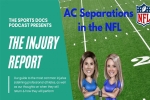Acromioclavicular (AC) Joint Injuries in the NFL: Return to Play and Performance Outcome

Let's chat about acromioclavicular (AC) joint injuries in the NFL.
We will start with an anatomy review of the AC joint, follow it up with a discussion on mechanism of injury and treatment, then discuss what we know about performance once players return.
Here the full episode here.
The AC joint relies primarily on ligamentous support for stability - including the coracoclavicular (CC) ligaments, the AC ligaments and joint capsule.
AC separations typically result from a direct blow to the outer aspect of the shoulder with the arm close to the body. Typically in the NFL we see a player getting tackled and coming down directly onto the outside of the shoulder with another player landing on top of them.
The Rockwood classification separates AC joint injuries into six different types based on amount of collarbone displacement and the direction of that displacement, and is useful to guide treatment.
The vast majority (~96%) of AC separations are low grade, type I and II, which are treated well without surgery.
In the NFL, athletes lose roughly 10 days per injury, with quarterbacks losing the most time at an average of 17 days.
There are no studies to date that evaluate performance after AC joint injury, but studies that look at other shoulder injuries (rotator cuff, SLAP tear, clavicle fracture) show no impact on performance.







